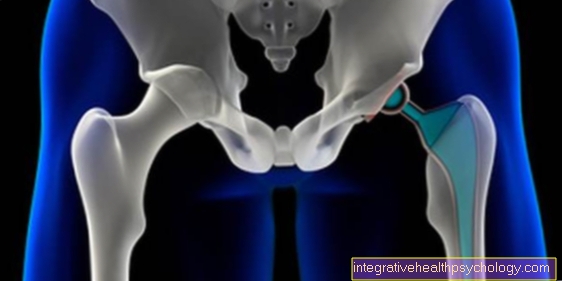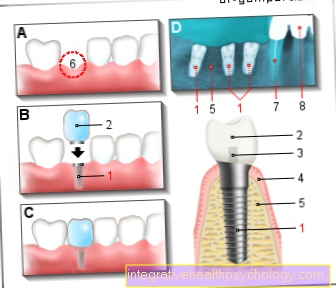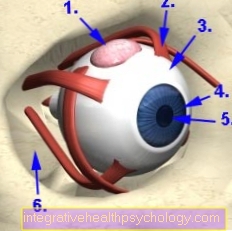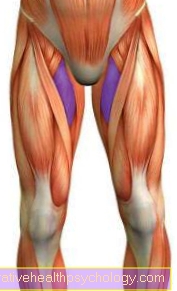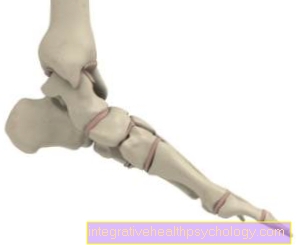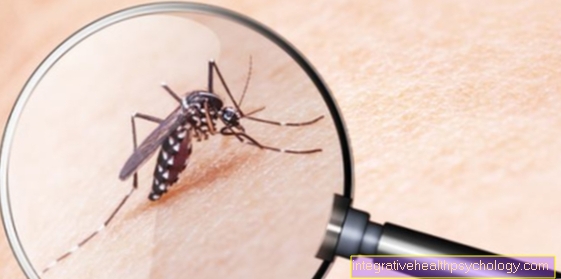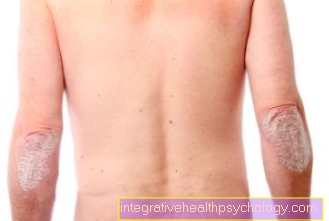Medication for bronchial asthma
introduction
A number of different drugs are used for asthma. Depending on the severity of the asthma, these are prescribed based on the graded scheme.
One can first differentiate between the anti-inflammatory drugs containing cortisone and those that work by widening the airways.

Drug groups for bronchial asthma
Glucocorticoids are one of the most important groups of drugs against asthma. Cortisone belongs to the glucocorticoids. They have powerful anti-inflammatory effects and are therefore very effective. On the one hand, the glucocorticoids can be inhaled and thus help in acute attacks; on the other hand, they can also be taken as tablets and thus prevent attacks.
Another important group of drugs in the treatment of asthma are bronchodilators. They dilate the bronchi and are therefore mainly used by inhalation. There are three other groups of bronchodilators:
- First there are the beta2 sympathomimetics, which in turn are divided into the fast and the longer-acting beta2 sympathomimetics (SABA and LABA).
SABAs are used for immediate therapy in acute attacks, while LABAs are only used in advanced stages of asthma.
- The bronchodilators also include anticholinergics and theophylline derivatives. However, these are not used that often in Germany.
- The third group of drugs that is used are the leukotriene receptor antagonists. Like the glucocorticoids, they have anti-inflammatory effects. However, they cannot be used for the acute therapy of an attack, only prophylactically.
Inhalative glucocorticoids and LABA are preferred in asthma therapy and SABA in acute attacks. Leukotriene receptor antagonists are used as an alternative if standard therapy does not work or is not tolerated.
Find out more at. Bronchial asthma therapy
Typical asthma medications
Various drugs containing cortisone are used to treat bronchial asthma. The main active ingredients are:
- Beclometasone
- Budesonide
- Ciclesonide
- Fluticasone
- Mometason
You might also be interested in this topic: Salbutamol spray
Beclometasone in bronchial asthma
Beclometasone diproprionate can be used to treat all degrees of bronchial asthma and COPD. It is inhaled as a powder or solution.
The dosage for adults is between 0.2 and 0.8 mg per day, depending on the severity of the disease. The daily dose can either be taken once in the morning or in the evening, or it can be divided into two doses. The maximum daily dose of 0.8 mg should not be exceeded by adults in the long term.
In children, the maximum daily dose is 0.2 mg.
Studies have shown that inhaled amounts of 1.6 - 2.0 mg beclomethasone propionate impair the function of the adrenal cortex and thus reduce the body's own cortisone production. If necessary, consult the attending physician.
Also read our topic: Emergency spray for asthma
Budesonide for bronchial asthma
Budesonide is also intended for the treatment of bronchial asthma of all degrees and of COPD. Budesonide preparations are available for inhalation as a powder, suspensions (very fine active substance particles in solution) or solutions. The powder for inhalation may lead to a fungal infection in the mouth, so that this dosage form is not intended for long-term treatment.
For long-term treatment of asthma, the daily dose of budesonide for adults should not exceed 0.8 mg.
At the beginning of therapy, until the symptoms reduce, maximum daily doses of up to 1.6 mg are permitted. In children, the maximum daily dose should not exceed 0.8 mg.
The effect can occur within 1-2 days, but it is only optimal after approx. 2 weeks. Compared to the other active ingredients listed here, budesonide has a lower depot effect.
A typical drug that combines budenoside with a beta agonist is e.g. Symbicort.
Read more about this under: Symbicort
Ciclesonide in asthma
Ciclesonide has been approved for the basic treatment of mild to severe bronchial asthma on the German market since 2006. It is used with a metered dose inhaler (pump pump from the inhaler) once a day, either in the morning or in the evening.
The recommended daily dose is 80 - 160 µg. An initial improvement occurs within 24 hours. So it is not an emergency medication.
For the time being, preparations with ciclesonide are only approved for patients older than 18 years, as there is insufficient experience with the treatment of asthma in children.
Fluticasone in bronchial asthma
Fluticasone propionate is inhaled as a powder or suspension. It is only available in combination with salmeterol. This is a long-acting ß2-sympathomimetic; a class of drugs that is also used for asthma therapy
In severe asthma, cortisone alone is sometimes not enough.Therefore, long-acting ß2-sympathomimetics are also given, which are best taken at the same time as the cortisone preparation.
In the past, the patient needed an inhaler for each preparation. Combination preparations of glucocorticoids and ß2-sympathomimetics, also called fixed preparations, facilitate application.
Mometasone in bronchial asthma
Mometasone furoate has been on the market since 2003 as a drug for severe asthma and COPD. It is taken as an inhalation powder. It is also used as an ointment for various skin diseases.
The maximum daily dose is 800 µg and is only recommended for severe asthma.
In the longer term, a daily dose of 400 µg is advisable, either inhaled at once or divided into two doses of 200 µg in the morning and evening.
Mometasone furoate is not recommended for the treatment of children. Studies have shown that fungal infections in the oropharynx increase in high doses.
That is why you should make sure that you rinse your mouth after inhaling, especially during asthma therapy. Furthermore, long-term high doses> 800 µg can impair the function of the adrenal cortex.
Spiriva for asthma bronchial asthma
The active ingredient of the drug Spiriva® is tiotropium.
Spiriva® is used in the context of so-called COPD (chronic obstructive pulmonary disease). The main symptoms of this disease are a chronic cough and increasing shortness of breath.
Therefore, it is not actually a drug for asthma, but is used for the accompanying asthma component in COPD.
Spiriva® dilates the bronchi and relieves shortness of breath and, through regular use, also reduces the occurrence of acute worsening of the disease.
Read more on the subject: Spiriva®
What medicines for asthma contain cortisone?
Many drugs used to treat asthma contain cortisone. The standard preparation for long-term asthma control are gluccocorticoids, which usually contain active ingredients similar to cortisone or cortisone. Glucocorticoids, which are used for asthma, are beclometasone, budesonide and fluticasone. However, these are usually very effective.
Alternatively, leukotriene receptor antagonists (LTRA) can also be used for long-term therapy. However, not all patients benefit from antileukotrienes. The indication for use must be made by the doctor. These do not contain cortisone.
Beta2 sympathomimetic sprays such as salbutamol are usually used for an acute asthma attack. These do not contain cortisone.
However, nowadays there are also combination sprays with a beta2 sympathomimetic and a glucocorticoid. It is therefore advisable to ask the pharmacy or doctor specifically whether this drug contains cortisone. In the case of severe asthma, medication containing cortisone cannot usually be avoided.
Read more about this under: Cortisone spray
Are there any over-the-counter drugs for asthma?
The over-the-counter medications that can be used for bronchial asthma are not highly effective and are not suitable for an acute attack.
- Cromoglicic acid has a prophylactic effect in allergic asthma as it has an anti-inflammatory effect. It is also well tolerated when taken over a longer period of time.
- Cetirizine can also be used for allergic asthma. However, these two drugs are hardly effective in non-allergic asthma.
- Expectorant drugs, which are also used against colds, are also available without a prescription. These include the active ingredients acetylcysteine (e.g. ACC), bromhexine and ambroxol.
Because the range and potency of over-the-counter drugs for asthma is limited, they should not be relied on for treatment. For therapy, a doctor should always be consulted, who can prescribe prescription drugs. These are particularly important for acute asthma attacks. The attending physician should be informed about taking a non-prescription drug.
You may also be interested in this topic: Asthma spray - what to watch out for!
Recommendations from the editorial team
- bronchial asthma
- Asthma spray - what to watch out for!
- Bronchial asthma symptoms
- Bronchial asthma therapy
- Viani







